
Kings Park Psychiatric Center’s Building 93
The ruins of Long Island’s Kings Park Psychiatric Center are often described as the perfect setting for a horror movie, and sure enough, several have been shot here. Poe and Lovecraft’s narrators may have been writing from asylum cells, but today’s horror heroes are venturing inside the abandoned ones. As shuttered institutions across the United States fall into decay, the insane asylum is showing up with increasing regularity in our scary movies, TV shows, books, and urban legends, quickly becoming synonymous with vengeful spirits, villainous doctors, and murderous mental patients. But while we may enjoy the “thrill of the shudder” while looking back at these places, we should be wary of reinforcing the stigma of mental illness and overlooking the nuanced history of American institutions.
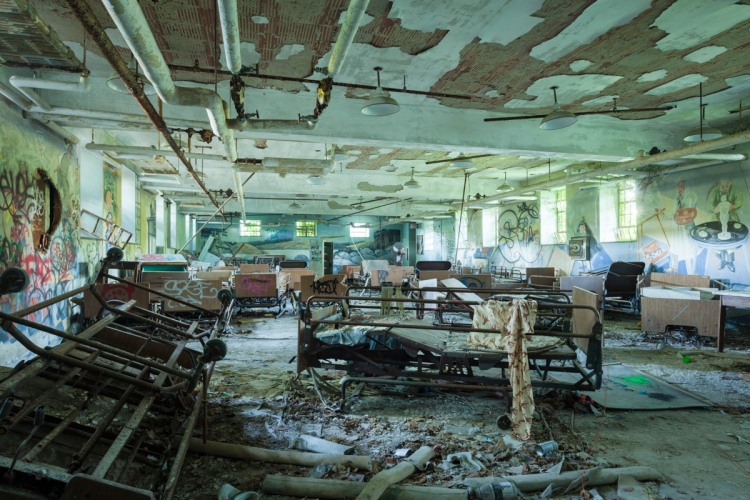
A craft room on the ground floor still held looms and half finished rugs. (Prints Available)
Established in 1885 by the city of Brooklyn prior to the consolidation of the five boroughs, Kings County Asylum followed the farm colony model popular at the time, designed as a self-sufficient community where residents were put to work raising crops and livestock to support the sprawling campus. The labor was thought to be therapeutic, occupying the time and attention of residents and keeping costs down. Early in its history, Kings Park was composed of a group of cottages meant to avoid the high rise asylum model which was already viewed as inhumane. But demand soared as the population skyrocketed in New York City into the 1930s, and in 1939 the institution resorted to constructing Building 93, a 13-story structure whose design was strikingly similar to what it had sought to avoid. At its peak in the 1950s, Kings Park reached a population of over 9,000 residents, who were divided by gender, age, temperament, and physical limitations through a complex of over 100 buildings, which included power plants, fire stations, staff housing, hospitals, recreational facilities, piggeries, and cow barns.

Beds may have been moved down in 1996 when Kings Park’s last residents were relocated to nearby Pilgrim State.
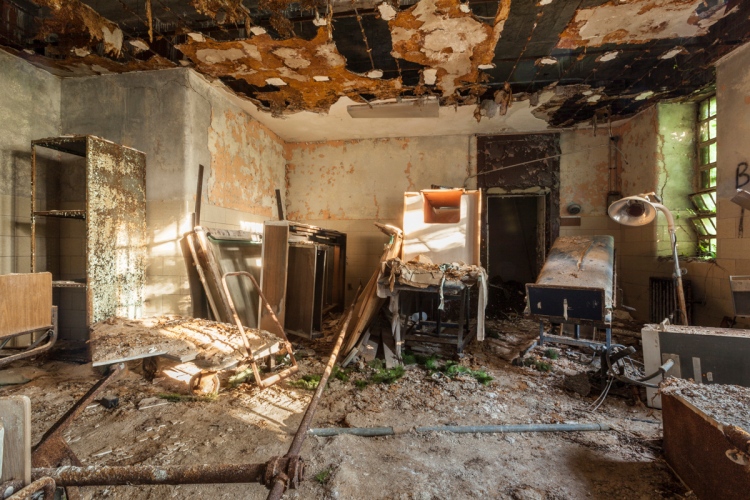
Furniture and equipment left behind on the ground floor.
Throughout its history, Kings Park was notable for staying on the cutting edge of psychological science, cementing its place in history as an early adopter and proponent of a succession of new procedures and medications that eventually led to the institution’s decline. In the first half of the 20th century, the psychological community was in a state of desperation, charged with the task of caring for a growing number of mentally ill patients with few treatment options available aside from psychotherapy and the rampant use of restraints and confinement. The 1940s saw the rise of two groundbreaking, albeit crude, procedures that gave doctors effective tools to manage extremely disturbed patients for the first time.
Shock therapy was conceived when doctors observed that the mood of epileptic patients suffering from depression improved after a seizure. The procedure aimed to replicate these benefits by inducing a seizure through electricity or insulin injection. Electroconvulsive therapy, as it’s known today, is still considered an effective treatment, even having a resurgence in recent years. But today’s advanced anesthesia and precise control of the duration and physical effects of seizures is a far cry from what patients went through in the 1940s. Strapped fully conscious to a hospital bed, patients could convulse for up to fifteen minutes at a time, often with enough force to fracture and break bones. Once a patient was admitted to an asylum, they had no right to give or deny consent for these procedures, and in many cases, shock therapy was used as a punitive measure to keep unruly residents in line.
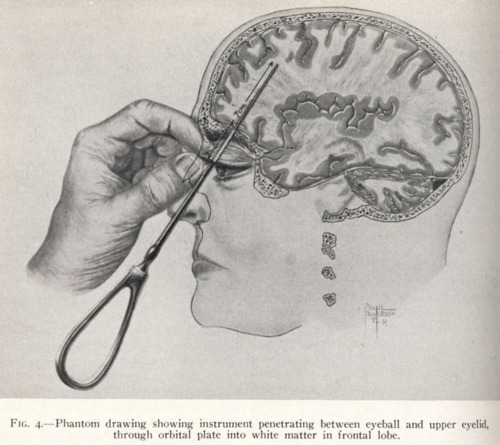
Early diagram of a transorbital lobotomy.
The lobotomy is remembered as one of the most grotesque treatment methods of the era. It was a simple procedure, in which a metal tool was inserted through the eye socket into the skull cavity, and wrenched around to sever the connections of the pre-frontal cortex from the rest of the brain. It was an imprecise and brutal operation, which left lobotomized individuals with no trace of their former selves. Though proponents of the procedure called these results a “second childhood,” lobotomized patients might have been more accurately described as zombies—extremely violent and disturbed residents would be rendered permanently docile, passive, and easy to control. Though it was controversial even in its time, its first proponents were awarded a Nobel Peace Prize in 1949 for their discovery.
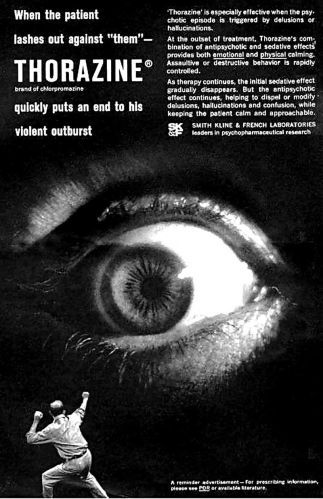
A 1960s advertisement for antipsychotic medication.
The development of effective antipsychotic medication in the mid-1950s signaled the decline of these extreme measures and the institution system as a whole. For the first time, residents once considered hopeless were able to manage their mental illness and live independently. This led to a dramatic shift in institutions across the country from severe overcrowding to near-abandonment as a trend of deinstitutionalization swept through America into the 80s and 90s. But as anxious as the powers that be were to put this dark period of history behind them (and cut funding out of state budgets,) they may have done too much too soon. While medication has made it possible for most people living with severe mental disorders to function on their own, there is still a sizable percentage for whom the available medications are ineffective. Reputable group homes for the mentally ill are few and far between, and out of reach for individuals without a solid support system in place. Many suffering from severe mental illness today are living on the streets, and a growing number end up incarcerated, without proper access to quality psychiatric care. Today, Kings Park stands as a testament to a bygone era, but the problem it sought to address remains unsolved.
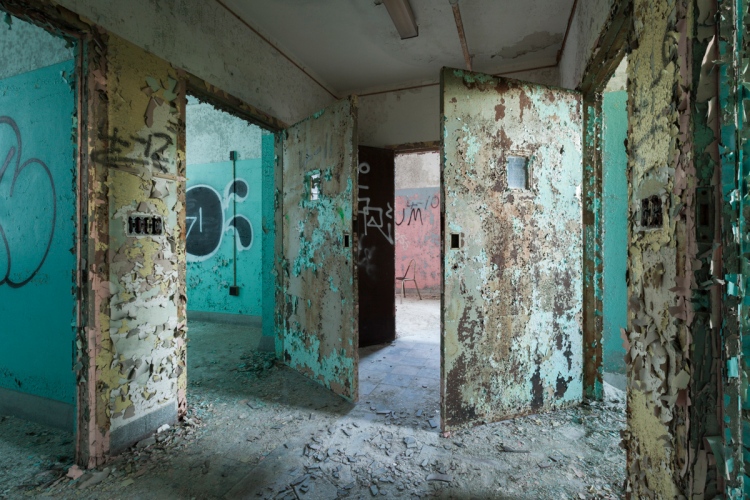
Layers of colored paint peel from a hallway of isolation rooms. (Prints Available)
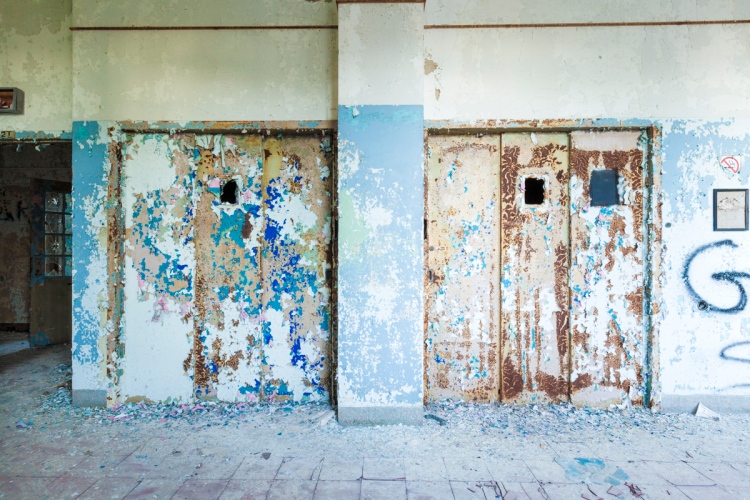
Lower floors housed able-bodied residents with large day rooms, while the infirm were confined to the upper levels.

Each floor was nearly identical, with subtle variations in color and layout.
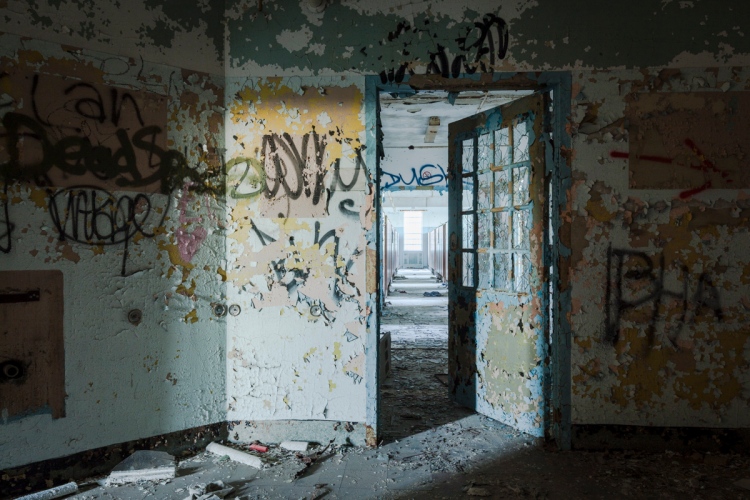
A central hallway connected day rooms, dormitories, dining halls, and isolation chambers. (Prints Available)
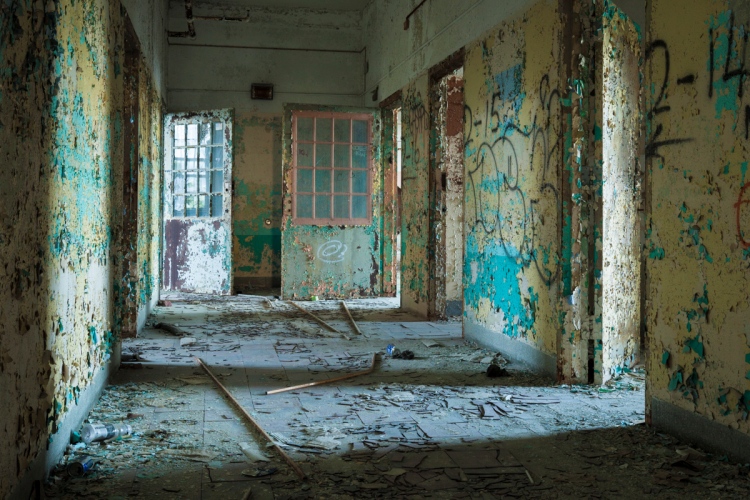
Patient rooms leading to the cafeteria.

Vines overtaking the exterior of Building 93.


Hey Will, so good to have a new posting!! The narrative and photos are fantastic. The video is really fascinating, looking forward to seeing more of them. Many thanks!!!
LikeLike
Posted by Frank Brennan | 6-17-14., 7:09 pmwhy is it assumed that the “murals” were made by patients ?
i don’t think spray paint was available at that time – if so, i wouldn’t think it was available to patients.
the “murals” seem to be more in the style of graffiti, more up-to-date .
LikeLike
Posted by Anonymous | 1-23-18., 1:08 amWrong. They were painted by patients it’s documented in the Park Office building.
LikeLike
Posted by Anonymous | 11-18-18., 3:11 pmExcellent point. I worked at the hospital in the late 1960’s and I remember watching patients doing artwork in recreational therapy classes. However, I don’t recall patients being allowed to paint on walls. It would be nice if others respond to your comments so it can be determined who actually did the paintings.
LikeLike
Posted by Mark Mathosian | 12-14-18., 4:07 amMark, I would like to answer your question: I painted all the murals.
LikeLike
Posted by Anonymous | 12-19-18., 8:52 amunfortunately many people have broken in and spray painted over the patient’s murals, some of the paintings are very beautiful however they are covering up parts of the buildings history that we will never get back. If you look closely you can see the different looking, older paintings underneath. Mabey not so much in these photos but every time I see it in person it is more covered up with graffiti and less noticeable.
LikeLike
Posted by Juliana Alber | 11-21-20., 7:38 pmHi Will,
Thanks for the posting about KPPC and also noting some of the current serious issues with the current Mental Health Care System due to lack of facilities (and care) after the closing of many of them during the past 30 years.
I believe there once were 500,000 Mental Hospital beds nationally, but sadly now there are just 40,000 beds. The “Geniuses” that run this country choose to ignore this issue and then wonder why there are so many gun related tragedies caused mentally ill people. I grew up near Kings Park in the 60s – 80s and remember some of my friends parents who worked very hard at KPPC to provide good care for the (10,000) patients residing there. Some of them were Vets. The issues occurring today didn’t happen in the past when facilities, such as KPPC, existed. When they started closing KPPC and other facilities in the 80s, I remember the large increase in mentally ill homeless people in Manhattan where I worked back then. It was distributing to see this happen and everyone knew it would lead to further problems in the future.
I also remember driving through the KPPC grounds which were always nicely landscaped. It wasn’t a scary place. The Center allowed community youth sports teams to use York Hall Auditorium (Building 80) for basketball and also use of their baseball fields. Some of the patients were allowed out during the day and I don’t remember any issues with them. Some of them were “real characters” and they enjoyed watching the kids play ball. It is sad to see what has happened, on many levels, since the demise of this facility and many others throughout the country.
They weren’t perfect, but much better than the alternative that we sadly live with today.
Thanks for your website. I enjoy reading the history behind the sites that you write about.
BJ
LikeLiked by 1 person
Posted by BJ | 6-17-14., 9:24 pmTo those shocked by the condition of the inside of this building as depicted in the photos. This facility was abandoned many years ago and was subsequently trashed for many years. It did not look like the photos posted on this website, when it was in use in the past. I know because I visited it in the 1970s when it was still in use. The State should have demolished the building and not left it and others to become biohazards. Will, hopefully you wore a mask respirator to avoid inhaling the old lead paint dust and asbestos insulation.
LikeLike
Posted by Fred | 6-18-14., 12:15 ami worked there as a nurse in 1989.. i was in building 22 admissions,, it was actually kept nice and clean
LikeLike
Posted by Anonymous | 10-27-15., 11:54 pmNo matter how nice the place was kept it was a BUTCHER SHOP!!!
LikeLiked by 2 people
Posted by Peter Senatore | 10-28-15., 10:38 amI worked in building 93 on and off during the late 60’s. Back then the building was full of patients, state employees and others going about their daily business. It certainly didn’t feel horrible at all. Looking at the ruins of any abandoned building is a bit spooky. Also, I don’t recall seeing any murals on the walls painted by patients. What I do remember is that the dining areas, living areas and day rooms were all kept very clean.
LikeLike
Posted by Mark Mathosian | 10-22-18., 4:15 pm@BJ: Actually there have been school shootings in the U.S. for about a hundred years that I know of, to say nothing of people who go on a rampage elsewhere as a prelude to suicide. It’s just that now every case gets reported nationwide within hours and chewed over for multiple 24-hour news cycles. Statistically, people with diagnosed mental illnesses are more likely than the general population to be victims of violence, not perpetrators. They also tend to die more frequently at younger ages, sometimes directly due to their condition (most often by suicide that does not involve violence toward anyone else), sometimes because they are poor and therefore underfed, cold, exposed to dirt, etc.
Some of the people at KPPC were not suffering from any form of mental illness. They had been committed because they were gay, or unruly teenagers, or unwed mothers, or unwanted dependents–a man could sign his children or even his wife over on his say-so not so long ago–or they had some form of mental retardation. Basically they couldn’t pass as prosperous, capable, and contented citizens fulfilling certain prescribed roles, so off they went. That kind of “care” does not need to come back, ever. But I agree with you that we need inpatient care for those who are suffering. The rationale when these facilities were closed one after another was basically, “Oh, gee, with these pills anybody can get a job that will support them and pay for the pills besides! The pills, they are perfect!” Ironically, it was magical thinking.
LikeLike
Posted by Jenny Islander | 6-18-14., 2:46 amWhat an amazing post. Your photos have an energy of their own. Thank you for sharing the background of this building and insight on mental illness.
LikeLiked by 1 person
Posted by TW | 6-19-14., 12:49 pmWhat about the other center Pilgrim State in Commack? It is older and much bigger than KPSC and also has a much more interesting history.
LikeLiked by 1 person
Posted by David Fischer | 6-25-14., 2:36 pmJust to give some history (the following was taken from the NYS OMH website):
“In 1927, New York Governor Alfred Smith, with public support, pressed the legislature to appropriate money to obtain a minimum of 10,000 beds needed to relieve overcrowding and treat the increasing numbers of people who would need treatment in a mental institution.
Such a big hospital had to be located out in the country where land was cheap. It had to be as nearly complete and self–sufficient as possible, generating its own electricity, pumping its own water and growing some of its food. One thousand acres in Brentwood was chosen for this to be another farm colony.
Pilgrim State Hospital was created by the Legislature in 1929 and named for Dr. Charles W. Pilgrim, Commissioner of Mental Health in the early 1900s. The hospital officially opened for the care and treatment of patients on 825 acres with 100 patients transferred from Central Islip State Hospital on October 1, 1931. Nine months later, 2,018 patients were hospitalized at Pilgrim. The census rose to its peak in 1954, with 13,875 patients.
Pilgrim was the largest facility of its kind in the world when it was built. The hospital community was independent in that it had its own water works, electric light plant, heating plant, sewage system, fire department, police department, courts, church, post office, cemetery, laundry, store, amusement hall, athletic fields, greenhouses, and farm.
Over time, as increasing numbers of patients were able to be discharged and greater support and services became available in the community, the need for such large facilities to treat the mentally ill was diminished. Following the trend, Kings Park Psychiatric Center and Central Islip Psychiatric Center were consolidated and relocated to the Pilgrim campus in the Fall of 1996. The following Fall, those facilities were merged into Pilgrim Psychiatric Center under one name. Today, Pilgrim reflects the history and best practices for care and treatment of all three facilities and has become a modern health care delivery system serving the mentally ill adults of Long Island.”
That is just the history that they tell you about. In my life I have been witness to escapes, murder investigations as well as a fire the somehow damaged two buildings not even near to each other.
LikeLike
Posted by David Fischer | 6-25-14., 2:47 pmYou mean Brentwood?
LikeLiked by 1 person
Posted by Anonymous | 4-21-17., 4:23 pmI would really love to go and explore this site. Was it tough to slip in undetected? I heard the police monitor it well.
LikeLike
Posted by sngblr | 6-29-14., 3:26 pmit is not difficult to explore the underground walkways, the building itself to the 13th floor atop the elevator generator, or the surrounding houses and buildings, just once inside follow the signs, when entering the underground be sure to take flashlights a bandana that’s well cleaned and lightly perfumed cause it smells horrible down there, it leads to the sister building nearby it or maybe beyond didn’t have enough light to find more alternative underground pipe, someone needs to find out about the spiral building ways out by the bar, go to google maps and zoom out just enough, it’s nearby the bar on maple hill?, start there, the grounds keeper cares, about the building, just don’t act like a criminal when u get caught just apologized and walk off, hes an old dude who doesn’t believe in ghosts or spirits even after I showed him the pic of the orb I had taken, good luck and don’t let fear grip you
LikeLike
Posted by theLADYKILLER222 | 5-24-17., 5:09 pmMy Aunt Dora who because of family secrecy I didn’t know existed until well after her death was a patient in Kings Park during the 1940’s and later. From what we could gather from bits and pieces of remembered conversations she had a lobotomy. Her brother, and my mother’s, George would visit her by taking the regular train from Jamaica to Kings Park station on the Port Jefferson branch of the Long Island Railroad and first stopping at the bar (now a Chinese restaurant) at the corner of Rt 25A and Indian Head Road. The Long Island had a Sunday only passenger train to and fro the grounds of the institution and perhaps Uncle George took that from Kings Park to the grounds. When it was functioning the railroad brought in a number of hopper coal cars to supply the hospital’s heating plant until it switched from coal use. Pilgrim State also had a Sunday passenger train. The grounds were very well kept.
LikeLike
Posted by Vincent J. Benkovitz | 2-6-15., 4:32 pmI called this place home from the late 80’s to 92 when they began discharging patients to Pilgrim State. Sad that I have lost contact with some of the caring staff like Georgia Raber of building 93.
Yes, the place sure was spooky!
LikeLike
Posted by Charles Harrilal | 4-26-15., 10:38 pmHey Charles, I remember your name but am unable to put a face to it, sorry. I worked there during those years that you were there, Georgia was awesome and there was another woman who worked with her who was gr eat too, unfortunately her name fails me at the moment. I was impressed by what they brought to the job considering the tough circumstances. I hope you are doing well Charles.
LikeLike
Posted by jim z | 1-15-17., 5:34 pmI remember Georgia’s co-workers name, I’m pretty sure it was Moira, and she was very nice…I thought she did a great job.
LikeLike
Posted by Jim z | 1-15-17., 6:03 pmCheck out this film on the haunted activities within KPPC: https://www.youtube.com/watch?v=789YsquCX_k
LikeLike
Posted by James | 5-27-15., 8:09 pmLets be real my aunt was in this place during the 1950s and 1960s until my mother finally got her out in 1968. This place was a BUTCHER SHOP,so let’s not hide the FACTS. My aunt was forced by the courts to go in because she would scream in class when students would come up behind her after she was scared to death by a intruder in her mothers home. She now lives with me. She came out of Kings 100 time worse then when she went in.
LikeLiked by 1 person
Posted by Peter Senatore | 7-14-15., 1:24 pmBarack Obama promised change but there is no change. The mental health system is broken and needs to be over hauled neither party has talked about fixing the mental health system. The reason we keep having a bunch of shootings has nothing to do with gun control it is because are mental health system is completely broken. Things are better some what at least no more shock therapy and ice baths and lobotomy anymore but look how many mentally ill people are in jail instead of a mental hospital look how man homeless people are mentally ill. I guess it does not matter enough because there is little to no talk about it. Also bad things happened in this building but also if you look past that the building is a beautiful building yet it is setting and rotting away. We need to sign a bill called the abandoned building act bill to save and protect all old buildings so they do not rot away and they can be preserved. Once historic buildings are gone there gone.
LikeLike
Posted by Brian Smith | 9-11-15., 6:41 pmMy grandmother often took me to visit my younger cousin who was in Kings Park in the early sixties. My aunt had abused and neglected, and, finally, had abandoned him. He was happy in Kings Park.
LikeLike
Posted by Anonymous | 9-18-15., 12:59 amI may have known him…
LikeLiked by 1 person
Posted by Mr jeff | 10-4-15., 9:28 pmHey Will have you made part II yet?
LikeLike
Posted by Robert George | 4-27-16., 10:39 pmWill have you made a part 2 yet?
LikeLike
Posted by Robert George | 4-27-16., 10:41 pmlets remember the good times we had there they also had a school like a high school for those who didn’t have their high school diploma I did a lot of drama and school work there. then they had little buildings that you went by in the center of entrance called soccer for those that could be taught how to live in the outside world. They also had jobs for u to make money so we could order out on Friday and we had cigg time on the units. I was there 86-92. I also remember the honor cards you could earn to leave the grounds but you had to earn them
LikeLike
Posted by Veronica Smith | 4-30-16., 1:10 pmI just got back home from a ride there at midnight just to look around instead I just got out to take a piss and leave because it didn’t look like something I wanted to be messing with went to go leave and my car litterally died scared the shit out of me but finally got it going not trying that again for awhile definitely not with the same car
LikeLike
Posted by Mucho | 5-1-16., 12:41 amI’ve been trying to do some research on Kings Park State Hospital because my mom was admitted there when she was around 14-years-old, in the mid 1960’s. I was wondering what building held the adolescent girls? She was sent there by her mother for running away. My mom doesn’t remember too much about the hospital because of multiple electroshock therapy treatments. It would be wonderful if somebody could give me some information. Thank you
LikeLike
Posted by Anonymous | 12-15-16., 2:33 pmIf you contact me I will send you an article I wrote about working at KP during the 1960’s. It will give you insight into what it was like during the time your mom was there. Mark mmathosian@aol.com
LikeLike
Posted by Mark Mathosian | 9-3-17., 6:38 amYoung adolescents and children were in building 22. If your mom was 14 then I feel certain she was in building 22. I worked there as a teen myself in the dining room. Older teens were transferred to a building called Group 5. I also worked in that building as a psychiatric aide. I believe the Group 5 building burned down.
LikeLike
Posted by Mark Mathosian | 7-17-20., 3:30 pmWhere is this
LikeLike
Posted by Cesarina | 1-10-17., 4:32 pmBuilding 7 is the most modern building out of KPPC buildings. It might not have asbestos because more modern. 7 could have been reused again. The inside of 7 and 93 is poor shape they should be gutted out and turned into malls and hotels keep the outside part which is still good. Turn 1 floor into a museum.
LikeLike
Posted by Brian Smith | 3-14-17., 11:36 pmFascinating. Some wealthy friends of ours – I recall their son as a teen, started to show signs of disruptive behaviors/bipolar disorder (?). Back then HE wound up at Payne-Whitney, an upscale East Side private hospital for people like him. His parents, steeped in denial described their son as ” really just a sensitive boy who needs a rest cure.. for his nerves..” Even the descriptive terminology was different, if you were rich enough to afford this type of care, you were described as being of an ’emotionally fragile, delicate temperament’ . Mental illness was also shameful, a thing to be concealed and never mentioned within your family. Hence the veiled language, I suspect. Famous people stayed at Payne-Whitney, often well-known celebs…Richie in fact, for all PW’s pricey accommodations – never actually received a proper diagnosis, an active treatment plan…or even, I regret, genuine help. He played the piano in the day room, for hours on end, and that was about that. Maybe some MIlltown, or the trank du jour. By the time his folks passed on, he was by then in late middle age, regularly abusing drugs and alcohol. I saw Richie right before he died of a heart condition, following decades of self-neglect. Money doesn’t buy happiness. Or, evidently quality mental health care, either.
LikeLike
Posted by Cindy Hawkins-Legorreta | 10-22-18., 1:04 pmMy grandmother was in building 93 in the 1940s. Her death certificate says she died by labotomy. She died the day after it was performed at the age of 31. She was there for 8 years and most likely had postpartum depression. Tragic because if she came there at a different time, say a few years later she would have most likely been treated with medication and had a life. Are there still any records somewhere of the patients who were there? I’ve been trying to see anything I can find on her and where she would have been buried. RIP Anne Regina Kun
LikeLike
Posted by n | 7-17-20., 3:05 pmI have been tortured brutally in these facilities all my life. They are entertainment for the inbred/hybrid who are a sodomite and also need to live off blood doping to de-mangle their repulsive face and harvest organs to survive. It causes extreme brain damage, and their business is disability racketeering and corporate treason and nothing else. All of their excessive businesses when you needed one business district to go to in a scientific manner was to pump AIDS sewage into the earth’s core and prey further on populations…
LikeLike
Posted by lorihalderson | 2-21-23., 10:25 amI have been tortured in these facilities my entire life. They are an inbred/hybrid who entertain themselves on the heinous torture of living things. They are a sodomite who live off of DNA blood doping to de-mangle their repulsive face and survive non-treatable diseases. They cause all illness on this planet and the brain damage is the worst. The other repulsive abomination they will get you into is their aged concentration camps which are just as disgusting…
LikeLike
Posted by lorihalderson | 2-21-23., 10:31 am